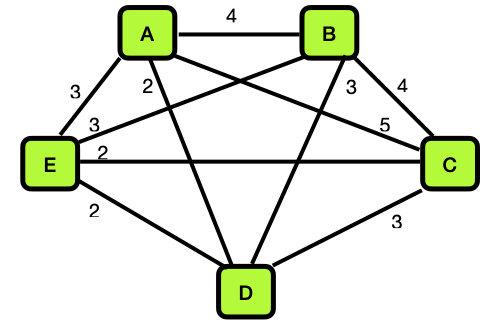Assignment on Approximation Methods
Approximation Algorithms for the Traveling Salesperson Problem
-
Pages 438-440 of the textbook describe how to use a Branch-and-Bound
algorithm to find an approximate solution to the Traveling Salesperson
Problem, and pages 444-448 describe a "Twice-around-the-tree"
algorithm that uses a different approach to approximate a solution.
- Graph A

-
For Graph A, consider both the Branch-and-Bound Algorithm and
the "Twice-around-the-Tree" Algorithm. In each case,
- If the algorithm can be applied to the graph, use
that algorithm to approximate a solution to the Traveling
Salesperson Problem.
- if the graph does not meet the required
assumptions for the algorithm, indicate what condition(s)
is(are) violated, rather than applying the algorithm.
- Graph B

-
For Graph B, consider the "Twice-around-the-Tree" Algorithm.
(In the interests of time, DO NOT use the Branch-and-Bound
Algorithm for this graph!)
- If this algorithm can be applied to the graph, use
the algorithm to approximate a solution to the Traveling
Salesperson Problem.
- if this graph does not meet the required
assumptions for the algorithm, indicate what condition(s)
is(are) violated, rather than applying the algorithm.
Approximation Algorithms for Roots of a Function
Suppose we are given a continuous function f, and we want to
approximate a value r where f(r)=0. (Jargon: r
is called a root of the function f.)
This section considers two approximation methods for finding the roots of
functions, the bisection method
and Newton's Method.
Work with these numeric methods requires you to graph functions, so
that you have a visual representation of a function's graph. For
this purpose, you can use any graphing software that you like. One
option is Graph
a function from desmos.com.
-
Enter a function in the box labeled "f(s) = "
-
To enter an exponent, use the caret caracter, so x4 would
be typed
x^4.
-
To change the domain or range viewed in the graph, click on
the wrench icon in the upper right of the window.
The Bisection Method
The following question is based
on the Reading on the
Bisection Method.
-
Write a program that uses the Bisection Method to approximate
a root of a function.
-
The start of the program should define a function
double f (double x)
for which the program is to find a root.
-
The program should define a new function
double find_root (double a, double b, double accuracy)
which works as follows:
-
find_root should use an assert statement to check that
f(a) and f(b) have different signs. (The program should
terminate if this assumption is not met.)
-
Another assert statement at the beginning of find_root
should check that the accuracy is positive.
-
find_root should continue to cut the interval in half,
following the Bisection Method, until either f(m)=0 for a computed
midpoint m or the newly computed interval is shorter than the
accuracy specified.
-
find_root should return the computed midpoint of the final
interval.
-
The main program should ask the user to enter endpoints a and
b and the accuracy. The main program then should
call find_roots with the appropriate parameters and report
the result.
Newton's Method
Consult Levitin's textbook, Section 11.4 for
details on Newton's Method, including the main formula.
Use the program newtons-method.c
to apply Newton's method to solve the following.
- Solve the equation x3 - 4x2 - 1 = 0.
-
Graph f(x) = x3 - 4x2 - 1 = 0
using Graph a
function from desmos.com or other graphing software.
-
The
program newtons-method.c is
already set up for the function f(x) = x3 -
4x2 - 1 = 0.
- After you compile and run the program, it will ask you
for an initial guess. Use the graph you obtained above to
determine a reasonable choice. What solution does the
program produce?
-
Find the cube root of n by solving the equation f(x) = 0
where f(x) = x3 - n. In particular, use
the program with this function (and its derivative) to find
the cube root of 27.
-
About how many iterations are needed to get a stable
result, if you choose 1 as the initial value
for x0.
-
Does using 27 as the initial value
for x0 require more, fewer, or about
the same number of iterations to obtain a stable result?
Explain briefly.
-
Check your answer. If you know the cube root of 27
without help, just give the answer and explain how you knew
the answer. If you need a calculator, feel free to use one,
but again describe briefly what buttons you used. (Many calculators
use Newton's Method, with an initial guess of 1, to take
square and cube roots.)
-
Repeat parts a, b, and c to find the cube root of 21.
created May 2, 2022
revised May 3, 2022
revised May 7, 2022
revised July 22, 2022
revised December 31, 2022–January 3, 2023
revised Summer 2023
revised April 9, 2024
|


|
|
For more information, please contact
Henry M. Walker at
walker@cs.grinnell.edu.
|

